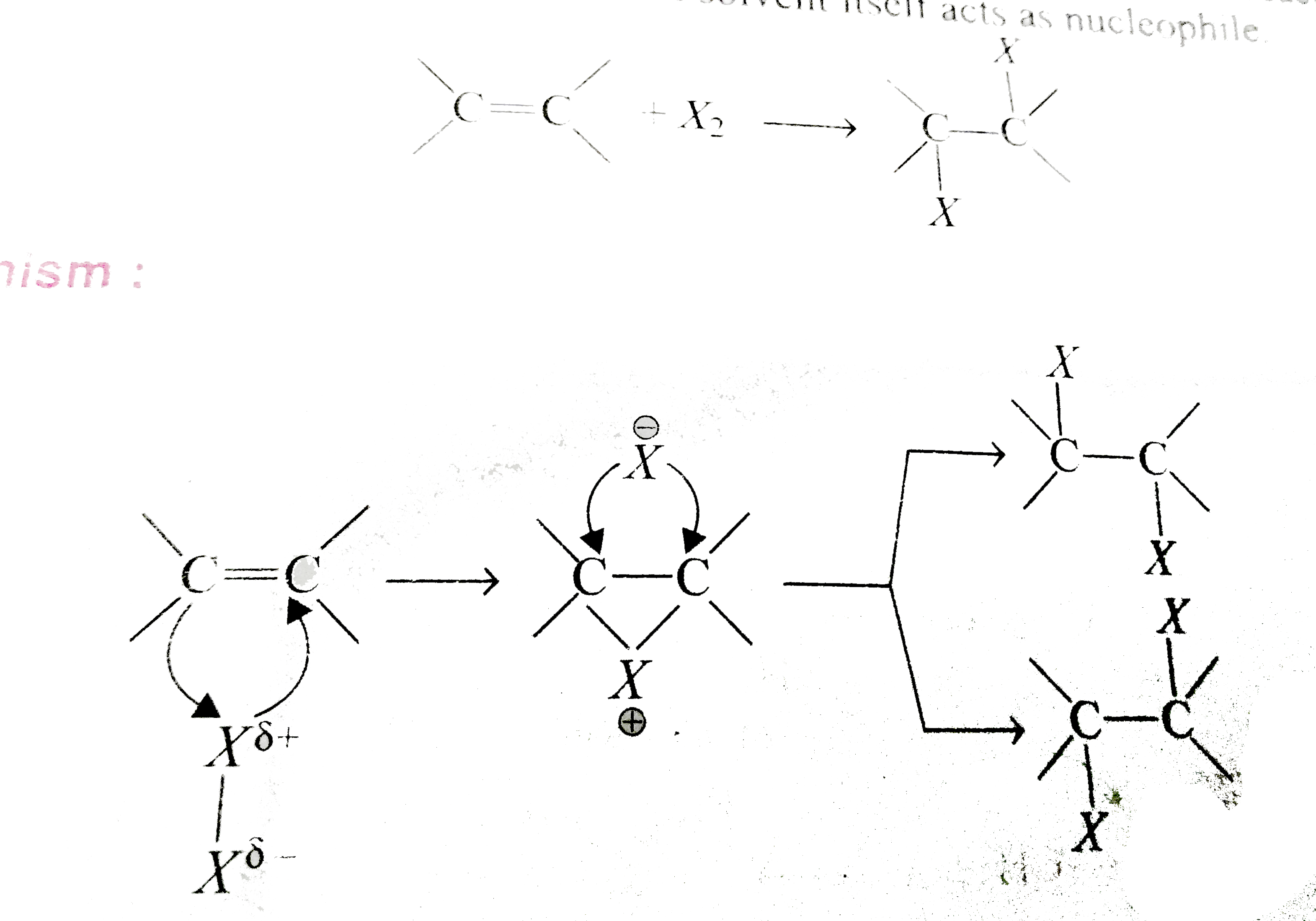Addition of X2 on alkene is electrophilic additon reaction.Reaction proceed through the formation of 3- membered cyclic halonium ion. Nucleophile X− attacks from backside of cyclic halonium ion hence total reaction is anti addition reaction.If this reaction proceed polar solvent then solvent itself acts as nucleophile.

Which of the following statements is incorrect?
Symmetrical trans alkene gives 2 products on reaction with Br2/CI4
Symmetrical cis alkene gives 2 products on reaction with Br2/CCl4
Trans alkenes give erythro product
Cis alkenes give threo product
The correct Answer is:A
Trans-alkane give meso product which is optically inactive
Topper's Solved these Questions
- BOOK - HIMANSHU PANDEYCHAPTER - HYDROCARBONS (ALKANE, ALKENE and ALKYNE)EXERCISE - Linked Comprehension Type (Q.26 To Q.33)8videos
HYDROCARBONS (ALKANE, ALKENE and ALKYNE)
- BOOK - HIMANSHU PANDEYCHAPTER - HYDROCARBONS (ALKANE, ALKENE and ALKYNE)EXERCISE - Match The Column12videos
HYDROCARBONS (ALKANE, ALKENE and ALKYNE)
- BOOK - HIMANSHU PANDEYCHAPTER - HYDROCARBONS (ALKANE, ALKENE and ALKYNE)EXERCISE - More Than One Correct (Q.26 To Q.50)25videos
HYDROCARBONS (ALKANE, ALKENE and ALKYNE)
Similar Questions
Alkenes undergo electrophilic addition reactions. Electrophilic addition to unsymmetrical alkenes involve the formation of a more stable carbocation intermediate in the first step which is rate determining and carbocation is then attacked by a nuclephile to form product
Which one of the following alkene reacts most readily with HCI?View SolutionAliphatic nucleophilic substitution is mainly of two type SN1 and SN2.SN2 reaction proceed with strong nucleophile in polar aprotic solvent. 3∘ halides do not give SN2 reaction. Inverted products are obtained in this reaction and mechanism of reaction occurs through the formation of transition state.
SN1 reaction proceed through the formation of carbocation in polar aprotic solvent. Solvent itself acts as nucleophile in this reaction. Racemization takes place in SN1 reaction.
Which of the following compounds will give SN1 reaction ?View Solution
Knowledge Check
- Question 1 - Select One or More
Which of the following reaction can proceed via formation of a 6 member cyclic transition state?
A B
B C
C D
D
- Question 2 - Select One
Addition of HX on alkene proceed through the formation of carbocation .This reaction is also kjnown as Markownikoff reaction.Accroding to Markownikoff's rule addition of electrophile occurs on theat crbon of alkene which have mor number of 'H' atom.

Which of the Following alkenes will give Markownikoff reaction?AF3C=CH=CH2oveset(HCI)BH⊕3N−CH=CH2HCl−−→CO2N−CH=CH2HBr−−→D
- Question 3 - Select One
Assertion:- SN2 reaction proceeds with inversion of configuration.
Reason:- The attack of nucleophile occurs from a side opposite to the halogen atom resulting in inversion of configuration.AIf both Assertion & Reason are True & the Reason is a correct explanation of the Assertion.BIf both Assertion & Reason are True but Reason is not a correct explanation of the Assertion.CIf Assertion is True but the Reason is False.DIf both Assertion & Reason are False.
Aliphatic nucleophilic substitution is mainly of two type SN1 and SN2.SN2 reaction proceed with strong nucleophile in polar aprotic solvent. 3∘ halides do not give SN2 reaction. Inverted products are obtained in this reaction and mechanism of reaction occurs through the formation of transition state.
SN1 reaction proceed through the formation of carbocation in polar aprotic solvent. Solvent itself acts as nucleophile in this reaction. Racemization takes place in SN1 reaction.
Which one of the following will give racemised product in C2H5OH?View SolutionAddition of HX on alkene proceed through the formation of carbocation .This reaction is also kjnown as Markownikoff reaction.Accroding to Markownikoff's rule addition of electrophile occurs on theat crbon of alkene which have mor number of 'H' atom.

Which of the following alkenes can produce diastereomers?View SolutionElectrophilic additions reactions proceed in two steps. The first step involves the additions of an electrophile. Name the type of intermediate formed in the first step of the following addition reaction H3C−HC=CH2+H+→?
View SolutionElectrophilic addition reactions proceed in two steps. The first step involves the addition of an electrophile. Name the type of intermediate formed in the first step of the following addition reaction.
H3C−HC=CH2+H+→?View SolutionElectrophillic addition reaction proceed in two steps. The first step involves the addition of an electrophile. Name the type of intermediate formed in the first step of the following addition reaction.
H2C−HC=CH2+H+→ ?View Solution
